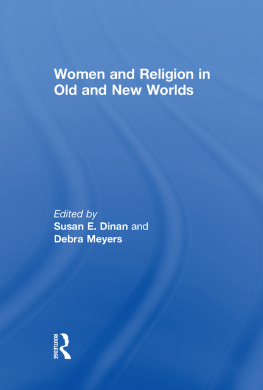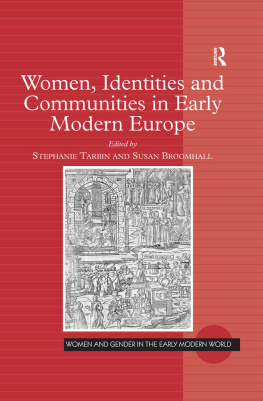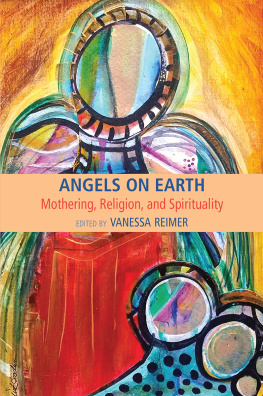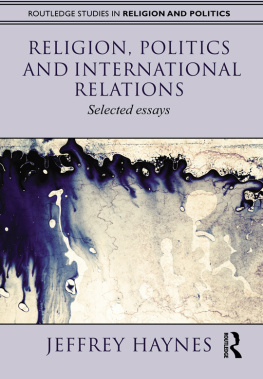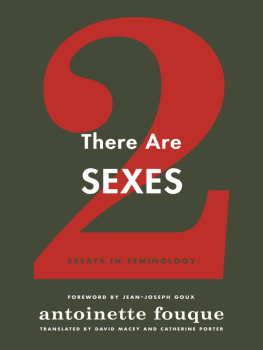WOMEN AND RELIGION
IN OLD AND NEW WORLDS
WOMEN AND RELIGION
IN OLD AND NEW WORLDS
EDITED BY
SUSAN E. DINAN AND DEBRA MEYERS
Published in 2001 by
Routledge
711 Third Avenue
New York, NY 10017
Published in Great Britain by
Routledge
2 Park Square, Milton Park
Abingdon, Oxon, OX14 4RN
Routledge is an imprint of the Taylor & Francis Group, an informa business
Copyright 2001 by Routledge
Design and typography: Jack Donner
All rights reserved. No part of this book may be reprinted or reproduced or utilized in any form or by any electronic, mechanical, or other means, now known or hereafter invented, including photocopying and recording, or in any information storage or retrieval system without permission in writing from the publishers.
Library of Congress Cataloging-in-Publication Data
Women and religion in old and new worlds / edited by Susan E. Dinan and Debra Meyers,
p. cm.
Includes bibliographical references and index.
ISBN 0-415-93034-0 (hardcover : alk. paper)ISBN 0-415-93035-9 (pbk.: alk. paper)
1. Women in ChristianityEuropeHistory. 2. Women in Christianity
AmericaHistory. I. Dinan, Susan E. II. Meyers, Debra.
BV639.W7.G46 2001
270.6082dc21
00-051710
CONTENTS
The authors and editors would like to thank the copyright holders for their permission to reproduce the following articles: Nuns, Kurakas, and Credit: The Spiritual Economy of Seventeenth-Century Cuzco, Colonial Latin American Review 6 (1997), pp. 185203; Recovering the Religious History of Dutch Reformed Women in Colonial New York, de Halve Maen 64 (1991), pp. 5359; and Anglicans, Catholics, and Nonconformists after the Restoration, 16601720, Women and Religion in England 15001720 (New York: Routledge 1996), pp. 185208.
We have incurred great debts of gratitude while putting together this collection of essays. First, we would like to thank all of the contributors for their diligence, patience, and promptness. We would also like to recognize the editorial assistance provided by Jeanie Attie, Jean Pedersen, and Allyson Poska. Thanks are also due to Jodi Bilinkoff and Merry Wiesner-Hanks for their early support for this project and their words of wisdom. Moreover, Routledge assigned us an anonymous reviewer who carefully read this collection and made numerous very helpful comments. Brendan OMalley and Jeanne Shu at Routledge have proven thoughtful and efficient editors.
Finally, we would also like to thank our husbands Benson Hawk and Jay Meyers for their encouragement and support; it is to them that we dedicate this volume.
WHILE THE EARLY MODERN CHRISTIAN CHURCH often acted as a vehicle for enforcing female subordination, it also provided opportunities for women to exercise authority and facilitate change as they redefined themselves and their positions within the Church, their families and communities. Indeed, womenProtestant and Catholic alikewere historical agents. The era of the European Reformations was one of enormous social transformation as western Christendom experienced a schism that resulted in a multitude of Christian churches and sects in the place of one Roman Catholic Church. The Roman Church, however, did not continue with business as usual; it re-created itself with a clearly articulated theology and a new, educated and disciplined corps of male and female reformers. Certainly both the Protestant and Catholic Reformations changed social attitudes about gender and behavior. By examining gender we hope to gain a better understanding of early modern society in western Europe. Toward that end, this comparative transatlantic anthology brings together some of the diverse experiences of Christians in Europe and the Americas during the post-Reformation era.
We have organized this book along two axes. First, we have structured it geographically. We compare four regions from the Old and New Worlds: Spain and New Spain, France and New France, the Netherlands and the New Netherlands, and England and New England and Maryland. This geographical framework asks the reader to consider the continuities and discontinuities between the Old and New Worlds. Second, this collection examines several related themes across national, continental, and denominational boundaries. At the intersection of these two axes is an examination of how gender influences religious experience and how religion influences gender construction. Consequently, the essays explore the relationships between lay and religious women, of similar and different faiths, and the interactions between women and men in churches, communities, and families. Women had unique experiences in distinct places and this volume seeks to highlight how women of various social strata and of different religious affiliations shaped and in turn were shaped by their faiths. Our focus is on ordinary women, some anonymous and some better known, who used religion to organize their daily lives and to make their everyday experiences meaningful. By studying the expectations women held concerning their faiths and their ability to serve their families, both spiritual and biological, we hope to draw attention to some of the distinctions between Catholic and Protestant experiences within the Atlantic community. Ultimately, we believe that one of the anthologys greatest contributions to historiography will be to apply a comparative transatlantic approach to the study of gender and religion.
REVIEW OF THE LITERATURE
This collection and other recent work on womens history are products of the social history movement of the 1970s. Social historians of the 1970s used new methods and documents to answer different kinds of questions about people of the past. They moved away from narrative political history to uncover the lives of ordinary people with a sympathetic eye toward race, class, and gender as factors in change over time.
In their quest for inclusion, feminist historians of the early 1970s also framed our understanding of gender and its historical significance. Ultimately, historians sought to determine not only how societies controlled women, but also ways in which women asserted their agency. Joan Kellys pivotal 1977 article asked the question Did Women Have a Renaissance? and concluded that they did not enjoy the same cultural and social advancements as did men.1 With this essay Kelly encouraged historians to question the universality of historical periodization and invited a reworking of traditional understandings of gender relations and the place of women in history. Similarly, Joan Scotts early work asked historians to question not only periodization, but also the arbitrary gendered categories of politics and war that comprised traditional male history. Ultimately, Scott called for a complete rewriting of history. Scott argued that women must arrogate the construction of historical understanding to wrest the production of knowledge about women away from their oppressors. Women could only obtain power and authority if they chose to rewrite the old (male) political history using new categories of analysis. Alternatively, Caroll Smith-Rosenberg and Bonnie Smith rejected the traditional view that women were merely victims of male oppression and assigned them roles as historical agents of change. Smith-Rosenbergs The Female World of Love and Ritual and Smiths Ladies of the Leisure Class focused on the distinctive world of women set apart from men in a separate sphere.2 They emphasized womens centrality as historical actors who created a more or less autonomous culture of their own that both epitomized female creativity and challenged the dominant male society. Using womens own words culled from letters and diaries, these authors suggested that the history of women could only be truly understood as separate from mens history because the traditional male categories of politics and events did not reflect womens reality. Collectively, Kelly, Scott, Smith-Rosenberg, Smith, and other feminist historians encouraged readers to rethink historical periodization and to apply gender as a category of analysis. Moreover, they opened new paths for research by legitimizing the use of unconventional sources (diaries, advice books, literature, and physicians documents) to uncover the lives of previously ignored historical figures. Thus, the feminist historians of the 1970s called for an expansion of what was understood as historical to include female as well as male subjects and subjectivity.


